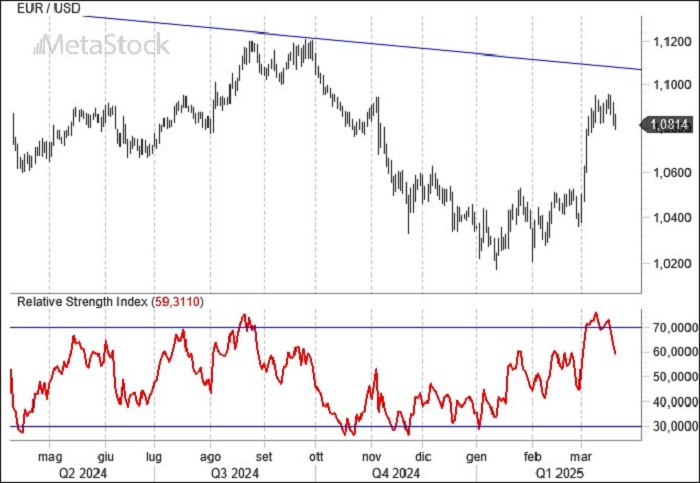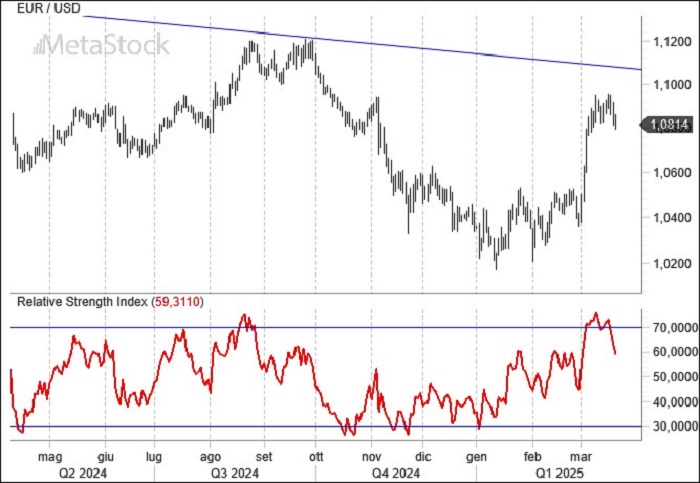- Powell opts against rate cuts in the U.S.; Trump urges him to act. The Fed has revised downward all economic growth forecasts, but not inflation projections, due to the new American tariff policies, necessitating caution in future monetary policy decisions.
- Europe is living through historic moments, with military concerns over Russian aggression prompting extraordinary defense and rearmament measures. Germany has abandoned its traditional austerity stance with a new massive debt-funded investment plan announced by Chancellor Merz.
- EUR/USD holds steady near key resistance levels of 1.09/1.10, confirming a shift in the technical landscape, now favoring the euro.
Federal Reserve’s Caution and Trump’s Push for Rate Cuts
The March meeting of the Federal Reserve made no changes to interest rates, keeping them unchanged, but issued a warning about the downside risks to growth caused by the protectionist measures implemented by the Trump administration. The central bank slashed its growth forecasts and raised inflation estimates due to tariffs. For now, predictions remain firm for two rate cuts in 2025.
The markets showed little reaction to the anticipated news, with the weakness of the U.S. dollar already reflecting the events. Trump, however, wasted no time in urging Powell to move forward with rate cuts to combat the economic slowdown, a scenario already anticipated by the White House.
Powell expressed concern over the rising inflation expectations, now above 3%. He also pointed to the reduction in growth forecasts for 2025 GDP, which has been lowered from 2.1% to 1.7%, with a slight improvement to 1.8% expected in 2026. Inflation is projected to remain just above 2% next year.
Powell justified the decision not to cut rates with the need for patience in monetary policy, emphasizing that acting too quickly could be detrimental. The low unemployment rate, he argued, advises against an immediate rate reduction.
Meanwhile, optimism in Europe after the approval of a massive funding plan for defense and infrastructure by the new German government under Merz has helped drive the euro higher, and has kept German 10-year yields close to the crucial 3% threshold, signaling a potential shift to higher yields in the future. Increased borrowing and the announced European defense spending plan make the ECB more cautious about future rate cuts, although at least two cuts are still expected, given inflation’s steady alignment with the 2% target.
Technical Analysis: EUR/USD Faces Key Resistance and Potential Pullback
As the quarter closes, it seems unlikely that EUR/USD will surpass the 1.113 mark. A close above this level would formalize a rare bullish engulfing quarterly pattern, signaling a green light for further euro gains in the months to come.
On a quarterly basis, EUR/USD has seen an oversold condition three times, confirming significant lows in 2000, 2015, and 2022. In all three cases, the exchange rate showed an excellent ability to bounce back, and the current move appears to be a continuation of the bull market that began in 2022, with the potential to push the exchange rate above 1.20.
The quarterly RSI, however, does not offer an equivalent signal to define when a primary peak will be established, but the current oscillator levels are not consistent with such a scenario.

Looking more short-term, the overbought condition (and the resistance at 1.10) is supporting a modest phase of easing on the euro before targeting levels that could be defined as crucial from a medium-term perspective, especially for those looking to hedge dollar-denominated assets, which is around the 1.12 area. As seen in the chart, the RSI above 70, like in the summer of 2024, suggests a pause or retracement of the upward move, with support around the 1.06 area proving useful to reload long euro positions.



Leave a Reply
You must be logged in to post a comment.